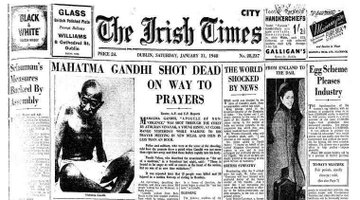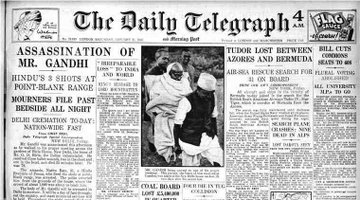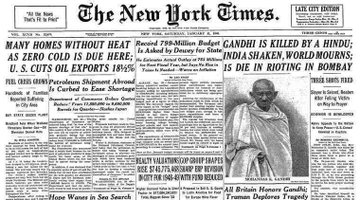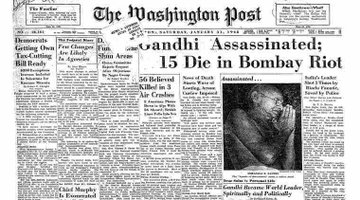India observes Gandhi''s death anniversary as Martyrs'' Day in the memory of its freedom fighters.
A Twitter account called Heritage Times has shared clippings from a few international publications that covered Gandhi's assasination. Gandhi's death made the front page of major publications such as the New York Times and the Washington Post.
The day the power of love overrules the love of power, the world will know peace. ~Mahatma Gandhi #MahatmaGandhi #Mahatma_Gandhi #MKGandhi
Renowned sand artist Sudarsan Pattnaik from Odisha, a Padma Shri awardee, paid tribute to the Mahatma, creating a sand installation themed around Gandhi's iconic glasses.
Remembering Father of the Nation on his 70th death anniversary #MahatmaGandhi . My SandArt at Puribeach .
Prime Minsiter Narendra Modi tweeted about Gandhi's death anniversary. "Remembering Bapu on his Punya Tithi," the PM tweeted.
पूज्य बापू की पुण्यतिथि पर उन्हें श्रद्धांजलि. Remembering Bapu on his Punya Tithi.
Mahatma Gandhi Shot Dead
Mahatma Gandhi, the Father of the Nation, was shot at 5-12 p.m.
to-day and he died fifteen minutes later. Gandhiji left his room in
Birla House for the prayer meeting a few minutes after the conclusion of
his talk with Sardar Vallabhbhai Patel. He passed through the garden
leaning on the shoulders of Ava Gandhi and Manu Gandhi, grand
daughter-in-law and grand niece.
As he walked up the four steps leading to the prayer mandap, a young man, aged about 35, came before Gandhiji and, bending his body forward at a distance of less than two yards, offered pranam. Gandhiji returned the salute, when the young man remarked “You are late to-day for the prayer''
Gandhiji smiled and replied, “Yes, I am”; but just at that moment, the young man pulled out his revolver and rang out three shots from point-blank range, the bullets piercing the frail body of the great leader just below the heart and stomach. Immediately, Gandhiji collapsed; but Ava Gandhi and Manu Gandhi stuck to their place by his side and held him firmly. But that was the last of the Nation’s Father. It was then 5.12 p.m.
The last act Gandhiji did was to lift both his hands as a sign of prayer in the direction of the large gathering which had assembled for the prayer. Thereafter, he was speechless and the loss of blood, at his age and so soon after his fast, made death inevitable. He was beyond medical aid even from the start when shock had its effect.
As he walked up the four steps leading to the prayer mandap, a young man, aged about 35, came before Gandhiji and, bending his body forward at a distance of less than two yards, offered pranam. Gandhiji returned the salute, when the young man remarked “You are late to-day for the prayer''
Gandhiji smiled and replied, “Yes, I am”; but just at that moment, the young man pulled out his revolver and rang out three shots from point-blank range, the bullets piercing the frail body of the great leader just below the heart and stomach. Immediately, Gandhiji collapsed; but Ava Gandhi and Manu Gandhi stuck to their place by his side and held him firmly. But that was the last of the Nation’s Father. It was then 5.12 p.m.
The last act Gandhiji did was to lift both his hands as a sign of prayer in the direction of the large gathering which had assembled for the prayer. Thereafter, he was speechless and the loss of blood, at his age and so soon after his fast, made death inevitable. He was beyond medical aid even from the start when shock had its effect.
Nathuram Vinayak Godse(36)was the assassin and soon after he fired the shots,he was seized by the people
who had come to attend the prayer. His revolver — a six-chambered one —
and some cash were recovered. It appears he was beaten by the crowd and
was slightly injured.
Mohandas Karamchand Gandhi(Oct 2,1869 - Jan 30,1948) was the preeminent leader of Indian Nationalism in British Ruled India who employed Non-violent Civil Obedience and led India to independence and inspired movements for non-violence, civil rights and freedom across the world.
Gandhi's Personal Life
Mohandas Karamchand Gandh was born in in Porbandar, a coastal town which was then part of the Bombay Presidency,British India.
Gandhi's father,Karamchand Gandhi(1822-85) belonged to the Hindu Modh Community,served as the Diwan of Porbandar State,a small Princely State in the Kathiawar Agency of British India.
In May 1883, the 13-year-old Gandhi was married to 14-year-old Kasturbai Makhanji in an arranged child marriage , according to the custom of the region.
In 1885, when Gandhi was 15, the couple's first child was born, but survived only a few days.
Gandhi and Kasturba had 4 more children, all sons -
- Harilal born in 1888
- Manilal born in 1892
- Ramdas born in 1897 and
- Devdas born in 1900
Gandhi Studied Law in London,U K
In 1888, Gandhi travelled to London, England, to study law at University College London, where he studied Indian law and jurisprudence and to train as a Barrister at the Inner Temple (one of the four (professional associations for Barristers and Judges in London)
Gandhi's attempts at establishing a law practice in Bombay failed because he was too shy to speak up in court. He returned to Rajkot to make a modest living drafting petitions for litigants but was forced to close it when he ran afoul of a British officer.
Gandhi in South Africa
In 1893, he accepted a year-long contract from Dada Abdulla & Co., an Indian firm, to a post in the Colony of Natal,South Africa ,then part of the British Empire.
Mahatma Gandhi (sitting in centre), who was practing as an attorney in South Africa, with H.S.L. Polak (left), then Gandhi's clerk, Schlesin (right), a Russian, and two office clerks behind
Gandhi spent 21 years in South Africa, where he developed his political views, ethics and political leadership skills.
In South Africa, Gandhi faced the discrimination directed at all coloured people. He was thrown off a train at Pietermaritzburg Railway Station after refusing to move from the first-class. He protested and was allowed on first class the next day.
Pietermaritzburg Station in South Africa where whre he was foced out a white only compartment - turning point of his life
Travelling farther on by stagecoach, he was beaten by a driver for refusing to move to make room for a European passenger.He suffered other hardships on the journey as well, including being barred from several hotels.
In another incident, the magistrate of a Durban Court ordered Gandhi to remove his turban, which he refused to do
These events were a turning point in Gandhi's life and shaped his social activism and awakened him to social injustice.
Gandhi Returns to India
In 1915, Gandhi returned to India permanently. He brought an international reputation as a leading Indian nationalist, theorist and organizer. He joined the Indian National Congress(INC) and was introduced to Indian issues, politics and the Indian people primarily by Gopala Krishna Gokhale.
Gandhi's first major achievements came in 1918 with the 'Champaran and Kheda Agitations of Bihar and Gujarat. The Champaran agitation pitted the local peasantry against their largely British landlords who were backed by the local administration.
In 1919 Gandhi became 'Khilafat Movement's' most prominent spokesman and attracted a strong base of Muslim support with local chapters in all Muslim centers in India .
Assuming leadership of the Indian National Congress(INC) in 1921, Gandhi led nationwide campaigns for easing poverty, expanding women's rights, building religious and ethnic amity, ending untouchability, increasing economic self-reliance, and above all for achieving Swaraj —the independence of India from British Rule.
In Dec 1929 Lahore session of INC adopts the goal of complete independece-poorna Swaraj for India
Gandhi led Indians in protesting the national salt tax with the 400 km (250 mi) 'Dabdi March' March 12 to April 5, 1930
In March 1931 Gandhi Irwin Pact Signed and Civil Dosobedience Movement Suspended.
Gandhi demanded the British to immediately 'Quit India' in 1942
In Sep 1942 Subhas Chandra Bose establish the Indian National army (Azad Hind Fauz)
In Oct 1943 Subhash Chandra bose proclaims the formation of Provisional Government of free India
In Dec 1943 Karachi Session of Muslim League adopts the slogan Divide and Quit.
In Feb 1947 Bfritish Prime Minister Clement Atlee declared that the British would leave India by not later than June 1948
In 1946, Mahatma Gandhi seen sitting next to a spinning wheel, a device used to make yarn or thread; the now-famous image came to symbolize the notion of Indian self-sufficiency — and thus independence from British rule


















No comments:
Post a Comment